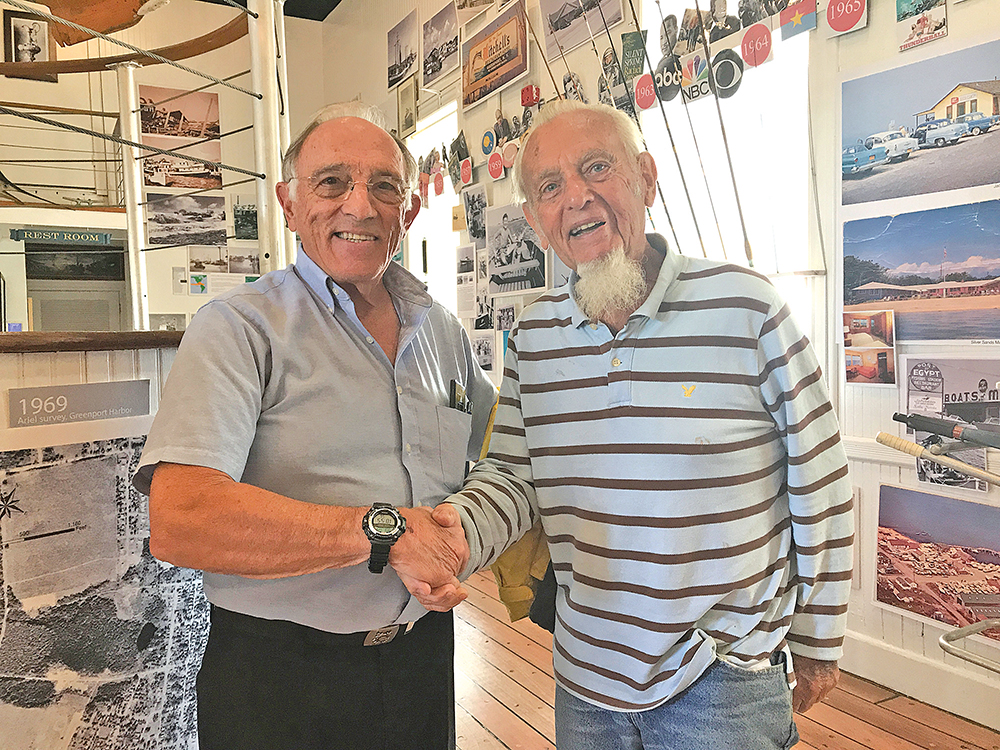Sherman Anderson was just 21 years old when he saved the life of a burly man 14 years his senior whose barge was taking on water near the Plum Island Lighthouse Station 64 years ago.
Last Wednesday, Mr. Anderson, now 85, told the story of that rescue to an audience at the East End Seaport Museum in Greenport — just miles from where he served for three years as a lighthouse keeper for the U.S. Coast Guard.
“I was on Plum Island Lighthouse with three other fellows,” he told those who had come to hear about his experience. “This was Dec. 15, 1955.”
As he tells it, he received a radio call from dispatchers in New London, Conn., telling him to look out for an 83-foot tugboat pulling a 115-foot barge coming through Plum Gut, the channel between Plum Island and Orient Point. His fellow servicemen were not in the lighthouse at the time — it was their night on the town.
“‘There’s a barge coming through Plum Gut,” he recalled being told. “It’s carrying 150 ton of trap rock, which is taking on water. There’s a [seaman] on the barge and the tug had to cut him off, otherwise, it would take the tug down.” The drifting barge had crashed in the rocks and Mr. Anderson ultimately saved that man — the only person on board.
Mr. Anderson spotted the man, later identified as 35-year-old Walter Helm, climbing aboard a small life raft and paddling toward shore.
“The 83-footer couldn’t get close to the barge to get the guy out,” he said, “because they didn’t want to crash … [Walter Helm] gets within 35 feet of the shore and, suddenly, he turns upside down.”
Water had gotten into Mr. Helm’s heavy jacket, pulling him into the water and causing the raft to flip. Mr. Anderson immediately drove his pickup to a nearby cliff, keeping his headlights on so he could see below, jumped into the water, pulled Mr. Helm upright and got him safely to shore. He said the entire process was automatic and that he still remembers the feeling today.
Battling 12-foot waves in frigid waters on what truly was — albeit something of a cliche — a dark and stormy night, he walked Mr. Helm to safety.
“Up the 25-foot cliff I help him,” Mr. Anderson recounted. “I’m not carrying him; he can do a little bit of walking himself — and into the shower, both of us.”
Into the shower of waves, that is. Luckily for the two men, the incident occurred near the time of slack tide, so currents weren’t as treacherous as they might otherwise have been. If the tide had been running faster, Mr. Anderson said, “I’d be gone.”
“I just held on to him and said, ‘This is the way,’ ” he said.
By then, the tug had pulled up and the captain told Mr. Anderson he saw the whole rescue and was going to nominate the young man for a gold lifesaving medal, a decorated USCG achievement.
Coast Guard officials reviewed the story and pictures, after which Mr. Anderson and his family traveled into Manhattan to accept the medal.
“The admiral shook my hand, he pinned the medal on me,” he said. “It was one of those things, you know? And he said, ‘Whatever you need after this, let me know.’ ”
Mr. Anderson took the admiral up on that offer, asking for an early release from service so he could go back to school. He graduated from the University of Connecticut, and then studied dental medicine at Fairleigh Dickinson University in New Jersey. An admitted C and D student in high school, he got his dental assistant certification in just one year and within seven years had earned his doctorate in dentistry. For 32 years, Mr. Anderson had a dental practice in Clinton, Conn. Today, he divides his time between West Virginia and Tennessee.
Backtracking, Mr. Anderson said the three other men who served with him at the lighthouse were higher in rank. He was only a seaman in his second year, and had just returned from training in Cape May, N.J., when the rescue occurred. Today, he says, the attention is too much because it’s the kind of thing people do every day.
“You just do it,” he explained. “That feeling comes over you or something. I don’t know what it is, but you feel stronger. You just see somebody out there that needs help, but people do that every day. They jump in front of the subway to pull people out. I’m not — there’s other people that do the same thing.”
After Mr. Anderson recounted that day in 1955, East End Seaport Museum board secretary Tracey Orlando and executive director Barbara Poliwoda handed him a small American flag symbolizing their appreciation.
“We are very, very grateful,” Ms. Orlando said. “In today’s world, not only are you a hero, but you’re a patriot. We are so blessed for you to come down and share your story and, just as a token, as a small friend, when you look at this, you know you got a friend here at EESM.”
Photo caption: U.S. Coast Guard Seaman Sherman Anderson, right, with Coast Guard Auxiliary Officer Ted Webb at East End Seaport Museum in Greenport last Wednesday. (Credit: Mahreen Khan)

Tidak ada komentar:
Posting Komentar